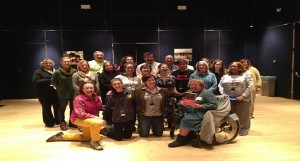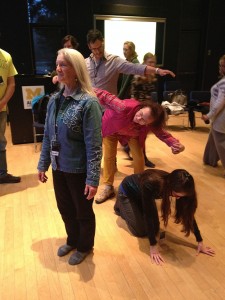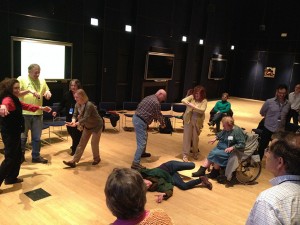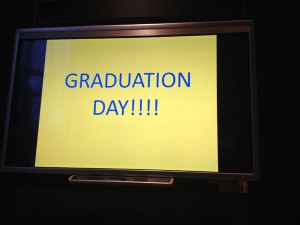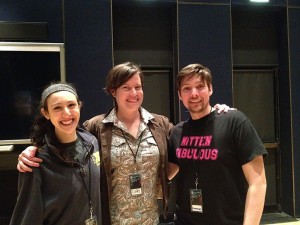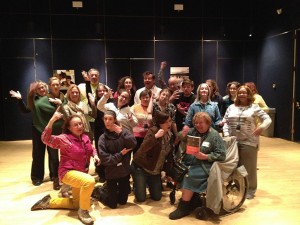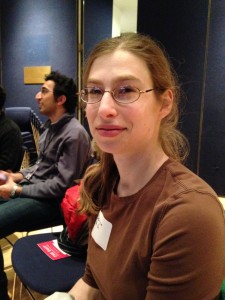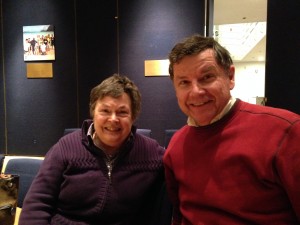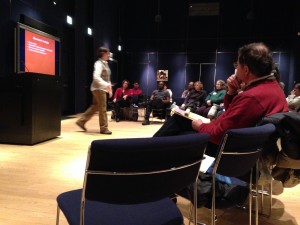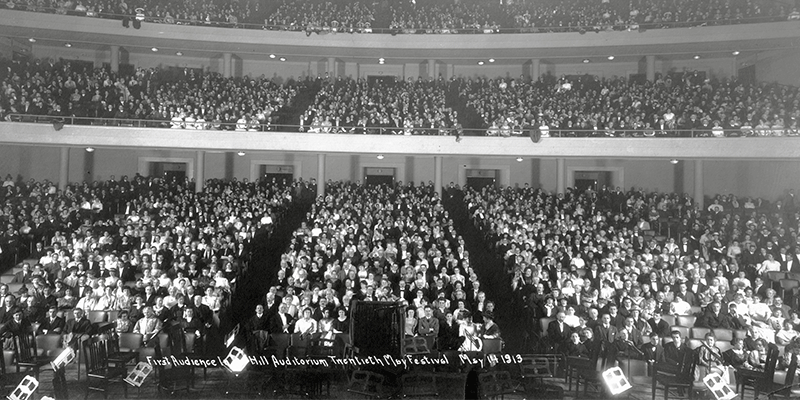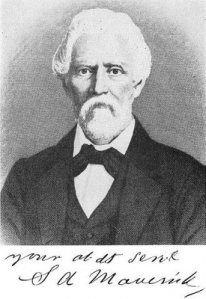UMS Night School Session 5 Recap: Reflection and Graduation
Please note: This post is a part of series about the free and open to the public UMS Night School. UMS Night School: Constructing Identity runs January 18-February 15, 2016.
On Monday, February 15, I attended our last UMS Night School session of the season. We chatted about the 2016 edition of UMS Night School, and our special guest speaker was Jennifer Harge, Artistic Director of Harge Dance Stories.
We began class with a different spin on the usual movement activity. Harge asked us to create two movements: one that reflected what others think of us, and another that reflected our self-image. Harge then asked us to draw upon a childhood memory to act it out. The purpose of this activity was to get us thinking about the difference between performing the movement as a child and performing it as an adult. This led into a discussion of Camille A. Brown’s Black Girl–Linguistic Play, which was performed this past Saturday, February 13 at 8pm in the Power Center.
We talked about how Brown’s work challenged the perception of dance. Harge explained that the work challenged the dancers in the show because they had to let go of everything they had been trained to do as dancers; they had to become naïve in order to successfully portray Brown’s experience as a young black girl.
One Night School student said that Brown’s work made him think of the old Peanuts Cartoons–the characters are all children, yet they each have their own idiosyncrasies as adults do.
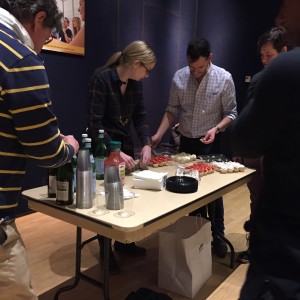 We ended by celebrating with a raffle, a perfect attendance award, and cupcakes!
We ended by celebrating with a raffle, a perfect attendance award, and cupcakes!
I’ve learned a lot about constructing identity as an artist and an audience member, and I’ve been introduced to several new and exciting ideas. It’s also been nice to step away from school and engage with community members from around the area. In the future, I strongly suggest that you experience at least one of these classes; the worst thing that could possibly happen by trying it just once is that you won’t win the perfect attendance award ;)!
Details about next season’s UMS Night School will be available in Summer 2016.
UMS Artist in Residence Update: Tanya Tagaq and the Poetry of Ecojustice
Editor’s note: Russell Brakefield is a poet and one of our 2015-2016 artists in residence. As part of this program, artists in residence attend UMS performances to inspire new thinking and creative work within their own art forms. Russell attended UMS Night School: Constructing Identity, featuring Taylor Mac and Tanya Tagaq, as well as Tanya Tagaq’s performance with Nanook of the North. Below is his response to the class and performance:
In her conversation as part of the UMS Night School’s series Constructing Identity it became apparent to me that Tanya Tagaq, in addition to being a well-renowned Inuk throat singer, is also a poet. Her work, she said, is interested in better representing the intense relationship her people share with the land. “The land eats us the way the city eats you,” she said. “Even our thread comes from sinew. We have a diet of souls.” What language, I thought. What voice! What purpose!
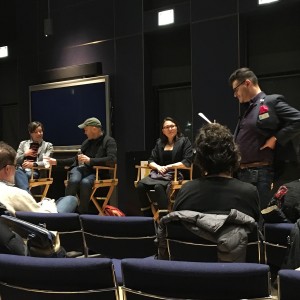
Pictured from Left to Right: Clare Croft, Taylor Mac, Tanya Tagaq, Jim Leija at UMS Night School.
The first issue of Poetry Magazine in 2016 carries with it the enigmatic theme of Ecojustice. In the introduction to the issue Melissa Tuckey writes that Ecojustice poetry “lives at the intersection of culture, social justice, and the environment. Aligned with environmental justice activism and thought, Ecojustice poetry defines environment as the place in which we work, live, play, and worship. It is poetry born of deep cultural attachment to the land and poetry born of crisis. It is poetry of interconnection.” This then—it seems to me—is the poetry of now, art that is essential, art that is necessary. Or perhaps this is the poetry of the perpetual now, evoked over and again in the ever-changing rush of violations against the environment, against marginalized peoples, the coupled plague there.
No matter the exact definition or the flourish of devastations that necessitates a genre such as Ecojustice, I’d like to place Tanya Tagaq and her breathtaking Nanook of the North performance squarely under this distinction. And her performance clarifies something else that I believe is crucial for art using this term—this performance was not only important but also transformative. It asked of its audience to feel as much as it asked of its audience to know. During her conversation for the UMS Night School Tagaq discussed her interest in inviting her audience to breathe, to leave the theater breathing in the experience of her people. She discussed her hope that this bodily reaction to her work would juxtapose with what the audience saw on the screen and disrupt what they knew already about the film Nanook of the North.
 Photo: Tanya Tagaq. Photo courtesy of the artist.
Photo: Tanya Tagaq. Photo courtesy of the artist.
The 1922 documentary is a spectacular work of art on its own, but it is also deeply afflicted with the stereotypes of its time. The film follows an Inuk man through his daily life in the Canadian Arctic. Often thought of as the first full-length documentary, the film was the source of an influx of dramatic ethnographic documentaries in the twentieth century. A New York Times review of the film from the year of its release praises filmmaker Robert J. Flaherty’s skill and innovation, which allows Nanook’s life to be “filled out, humanized, touched with the humor and other high points of a recognizably human existence. Thus there is body, as well as dramatic vitality, to Nanook’s story.”
But despite these groundbreaking cinematic achievements, this film also serves as a lasting reminder of the sneaky hand of history, the way people and places were routinely misrepresented or exploited in the name of art and entertainment by a dominating class of public artists. As a lasting and widely disseminated piece of art, the film perpetuates cultural insensitivity in the way that much popular culture of certain time periods does. Even as an effort of recording the practices of a people on the edge of displacement, the film raises questions for the artist and the archivist that harken back to the earliest conflicts with anthropological involvement.
Tanya Tagaq’s performance responds to both the positive impressions of the film and the negative. She embrace’s Nanook of the North for its representation of the hardships of life for her people. She draws connections between the landscape that is depicted so vividly in the film and the rich heritage and power of her people. But she also calls attention to the way the movie wrongly depicts Inuit culture, the stereotypes represented there, the omissions made out on the ice.
Her Nanook of the North performance combines traditional throat singing with other vocal textures, breath work, and movement. Tagaq’s performance is visceral, athletic, and jarring. And the performance does something the film cannot do by itself. She is not simply saying, look at this thing that is both beautiful and deeply flawed. She provides, in her accompaniment, a filter that accounts for cultural context. She provides a filter for our renewed sense of duty towards people, landscapes, and the relationships between the two. She makes art that ruptures the intellectual response to colonial fallout and instead invites audiences to re-read and re-feel the film. She invites us to breathe.
 Photo: Tanya Tagaq. Photo courtesy of the artist.
Photo: Tanya Tagaq. Photo courtesy of the artist.
I’m drawn to the idea of Ecojustice in part because it attempts to collapse the gulf between intellectual and emotional response. It also attempts to collapse the gap between social issues and issues of ecology. It is about connectivity. Somewhere amidst the heartbeat of Tagaq’s performance— drummer Jean Martin and violinist Jesse Zubot add a wild soundscape to the piece—I found my attention divided between the music and the film. I was drawn back and forth between the film and Tagaq’s winding, dramatic performance. I felt myself giving over to her incredible vocal work and at times needed to close my eyes. Tagaq was representing everything at once— the beauty and hardship of her people, the injustices there, the wreck of the land, her own place in the history of all this.
This performance made me thankful for the poets I read in my youth, poets like Wendell Berry and, more recently, poets like C.D. Wright. These poets, like Tagaq, showed me the potential of art to speak to the mistakes of history and the troubles of now. This type of work offers artists an opportunity to reclaim the past and unwind it, unfold it.
All art is a form of translation and all translation is a form of theft. And yet here Tanya Tagaq translates the miswritten story of the past and reaches into future, into the violent landscape of possibility we call innovation.
Interested in more? Follow the adventures and process of other UMS Artists in Residence.
UMS Night School: Constructing Identity – Session 3 Recap
Please note: This post is a part of series about the free and open to the public UMS Night School.UMS Night School: Constructing Identity runs January 18-February 15, 2016.
On Monday February 1, I attended my first UMS Night School session. For this particular week, we were lucky to have special guests Tanya Tagaq, performing February 2 at 7:30 pm, and Taylor Mac, performing February 5-6 at 8pm. The turnout for this session was high and the crowd was excited and interested to hear what the artists had to say in this casual yet upbeat interview.
Jim Leija (UMS Director of Education and Community Engagement) and Clare Croft (U-M Assistant Professor of Dance).
 Pictured from Left to Right: Clare Croft, Taylor Mac, Tanya Tagaq, Jim Leija
Pictured from Left to Right: Clare Croft, Taylor Mac, Tanya Tagaq, Jim Leija
Taylor and Tanya took turns talking about their upbringing. They were both expected to adhere to the social norms of their respective communities. At a certain point, both Taylor and Tanya were tired of being told to follow the rules and decided to rebel by branching out and letting their true identities be known. Taylor stated, “When I am on stage you listen to me, I am in charge!”
What is your artistic family tree?
Both Taylor and Tanya were influenced by music and other art forms at a very young age, and neither of them are classically trained musicians. Improvisation is important to both of them as performers, because it makes each show unique and special in its own way. Both artists use their performances as a way to connect with the audience in a profound way and always have an important message they hope to portray.
The floor was then opened up to audience questions. It was refreshing to learn that both Taylor and Tanya have changed over time as performers and to learn about what their ultimate goals were at a younger age as well as what they are now. As a student, I have sometimes been scared of becoming pigeon-holed into one career mindset when in reality there are multiple options and ways to achieve my ultimate goals.
The class was a fun and awesome learning experience; it was interesting to gain more perspective about different upbringings and lifestyle choices that people from vastly different regions can have.
UMS Night School sessions are free and open to the public. Drop into one or attend them all, no registration required.
Don’t miss the next class on Constructing Identity Together: Artists and Audiences with specials guests: Robin Wilson, Michael Parmelee, Daniele Fattore, and Salina Moeljadi, Monday February 8 at 7:00 pm.
UMS Night School: Acting and Dancing Identity – Session 2 Recap
Please note: This post is a part of series about the free and open to the public UMS Night School. UMS Night School: Constructing Identity runs January 18-February 15, 2016.

Photo: Tanya Tagaq, who will be interviewed along with Taylor Mac at the next session of Night School on January 25. Photo courtesy of the artist.
This past Monday, I attended my first UMS Night School session. This was the second session in this year’s series, which focuses on identity and performance.
The session was about acting and dancing identity, with a focus on Young Jean Lee’s Untitled Feminist Show and Straight White Men, both of which were presented by UMS January 21-23, 2016. A discussion also prepared us for next week’s UMS Night School session with special guest artists Tanya Tagaq and Taylor Mac.
Jim Leija (UMS Director of Education and Community Engagement) and Clare Croft (U-M Assistant Professor of Dance) opened the session with an interactive movement activity. We participants picked a gesture that resonated with us from one of the shows we had seen over the weekend (if we had attended one). We were to perform the gestures without speaking, to emphasize the power of the motion we chose. We then got a chance to explain our gestures to each other.
What surprised you?
We discussed identity through acting and dancing, our expectations of the shows, and the role of society in influencing the creation and content of the shows. One of the main questions that was put on the table was: “What surprised you at the shows?” This question propelled a fantastic, insightful discussion about identity and cultural influence on identity.
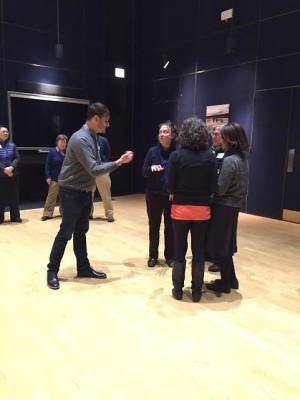 Photo: UMS Night School attendees perform their sound and motion as maestro Jim conducts them.
Photo: UMS Night School attendees perform their sound and motion as maestro Jim conducts them.
Jim and Clare closed the session with another interactive activity in which we created a “soundscape” for a picture that was projected onto a screen. The picture was of dogs pulling a sled through an arctic setting. Our class formed groups of four, and each group came up with a sound and action that we thought described some aspect of the picture. Maestro Jim then conducted the class in performing our sounds together. The result? Super awesome! It was nice to feel a sense of community with people I had never met before.
Having no preconceived expectation of the UMS Night School series, I found the class extremely engaging and by the end, I was so positively overwhelmed with so many new and exciting perspectives that I would’ve otherwise never been introduced to.
If you haven’t yet attended one of these classes, don’t wait any longer! Join us next week for a super exciting session to learn about constructing identity onstage with special guest artists Tanya Tagaq and Taylor Mac!
UMS Night School: Curious About Dance – Session 5 Recap
Editor’s note: This post is a part of a series by U-M student and UMS intern Hillary Kooistra, who’s covering our free UMS Night School: Curious About Dance workshop series.
Moving Forward
This past Monday evening, our last Night School session of the year, we celebrated an enriching, inspiring, and fun-filled five weeks by reflecting on our past lessons and looking toward future engagement opportunities. The time has flown and I cannot believe how quickly Graduation Day arrived, but before we could break out the Pomp and Circumstance, we had a stunning weekend of dance to unpack! We began our session with an exercise and discussion around this past weekend’s Abraham.In.Motion performances, then transitioned to wrapping up the entire semester. Over the course of the evening, we moved from speaking specifically about one company’s work to thinking in general terms about dance we’ve seen this season and will see in the future; once again proving that though there are infinite ways to approach movement exploration and discussion, similar concepts appear and circulate among these seemingly different dance works.
We began our session a bit differently on Monday night. Instead of sharing and repeating gestures, laughing at one another’s creativity or manipulating the movement we perceived; we stood in our circle with closed eyes. Checking in with ourselves and becoming comfortable in the space, we freed our bodies and minds to think about this past weekend’s double bill. When we opened our eyes, we assumed a pose that reflected a particular moment of resonance from either Friday or Saturday night’s performance. Instead of teaching and repeating one another’s poses, we split into groups and created tableaus: placing our individual gestures into a larger, multi-layered, ensemble-based story.
Left: Group 1’s tableau: “Evolution” aka “Static and Moving” aka “The Descent of Man (and Rise of Woman” aka “Past, Present, and Future” Right: Group 2 and Group 3’s tableau: “Gather and Cast Away” aka “Fronts and Backs” aka “Claws”
This exercise proved to be just as much about those observing as it was about those posing the tableaus. As we examined one another’s work, we shared our interpretations by thinking of possible captions or titles for each image. We discovered numerous ways to view and manipulate the tableaus–experimenting with movement and stillness, placing together two figures that were created separately to create one large image, crafting a sound score to accompany the posing bodies–and witnessed the infinite layers of perception we craft as we discover the infinite ways to shape a single idea. (Most importantly, we discovered that Jim has quite a fierce relevé.)
Group 3’s moving tableau: “Motion and Stillness” aka “Offering aka “Centrifugal People” aka “Soup Pot” (…? Thanks for that one, Jim. Go practice your relevé.)
The discussion of The Watershed and When the Wolves Came In that followed our art gallery visit demonstrated how Kyle, as a choreographer, takes a similar approach to develop complexities within his work. We questioned the motion of stillness, layers of rhythm, and pliancy of movement in each work, and recognized the historical and present-day contexts accompanying these more conceptual ideas. Though we might not be able to pinpoint the exact starting point of each specific work, we can see there are multiple ways to enter and navigate his dances, just as there were for the tableaus we created.
During our final post-performance group discussion of the semester, I couldn’t help but smile as I recognized how much we have grown over the past five weeks. With over a month of dance exploration under our belts, we can offer intelligent, informed, and inquisitive thoughts about any movement exercise or performance reflection we engage in. We have also developed a rich collections of dance experiences to pull from as we allow past dances we saw or lessons we learned to inform our perceptions of new works. And from learning labanotation to telling secrets through gesture, from watching a pas de deux of plastic bags to contemplating the historical imagery within a dance work that explores the enigma of freedom, we have certainly experienced more than a taste of everything offered, not only in this diverse UMS dance season but in the dance world as a whole.
We took all of these thoughts with us as we transitioned to the “graduation” component of Monday’s Night School session. The celebration began with some refreshments and prizes! A special congratulations to Fred, Harvey, Rebecca, Carol Rose, and Lisa, who were recognized for their perfect attendance, and to Susan for winning the Door Prize Raffle. Enjoy some pizza for all of us! Or better yet, take us with you! Though the cupcakes were delicious as always, I think the real treat was the peek inside the next UMS dance season, which looks absolutely incredible. The companies that visit us will certainly feed our growing curiosity and reveal even more ways to think about movement. There will be the same engagement opportunities that we know and love: You Can Dance Classes, Post-show Q&As (led by Clare, no doubt), and Sunday post-performance Brunch Tune-Ins. Next year’s Night School will focus on the UMS Renegade Series, which you should definitely attend if you want to know more about the outside-the-box, forward-moving performances that UMS presents.
Congrats, Grads!
So get ready to buy your tickets, which will go on sale after the official UMS Season Launch party, taking place on April 24th (right before the opening performance of Lyon Opera Ballet’s Cinderella) on the fourth floor of Rackham. It’s free and open to the public, so grab a friend, head to Rackham, and then go enjoy our last dance performance of the season! Though we won’t be convening in the Alumni Center to discuss, hopefully you will be able to share your impressions over coffee, dinner, or gestural movement after the show.
And that’s all, folks! Now that this semester of Night School is complete, please don’t be a stranger–to UMS, the Department of Dance, or movement in general (definitely not to movement in general…moving is important). There are plenty of opportunities to watch and engage in performance left this year: in addition to the UMS performance of Lyon Opera Ballet, the Department of Dance has a number of upcoming shows (including my senior BFA concert and Charles’s graduate choreography work!), that we would love for you to attend. In the meantime, tell your friends about all of the wonderful dance you’ve experienced, and hopefully we will see you in the Alumni Center next season! Thank you all for your wonderful questions, insights, and energy over the past five weeks!
Left: Much love from your Department of Dance Night School reps! Right: Our crazy, kooky, intelligent band of Night School folks. Performing gestures, of course.
UMS Night School: Bodies in Motion – Session 7 Recap
Editor’s note: This post is a part of a series covering our free UMS Night School: Bodies in Motion series. Learn along side with them.
On Monday, March 17, we focused on dance on camera, and the process of both creating dance for film and documenting dance through film. Special guests included U-M faculty members Peter Sparling (Dance) and Terri Sarris (Screen Arts & Cultures).
Download a recap of the session and related materials: UMS Bodies in Motion Session 7 – Key Theme, Players, and Definitions.
For next class
Night School continues at the same time and place on Monday, March 24 at 7 PM in the U-M Alumni Center. The next session will focus on “Making Ballet Personal” with special guest award-winning emerging choreographer Kyle Abraham. To prepare, take a look at an excerpt of his work below, and read Dance Magazine’s feature.
Additional resources
Special guest Terri Sarris also recommends:
Reines D’un Jour – directed by Pascal Magnin (selection shown during class)
Maya Deren’s Choreography for the Camera
For more of special guest Peter Sparling’s work:
Autophagy Suite (Projected onto UM Natural History Museum rotunda floor from above with 5 dancers in performance with scientist Dan Klionsky.)
Interested in even more dance engagement? Pick up an adventure card to learn all about the dance activities we’re offering this year and for a chance to win a backstage meet and greet.
Share ns, comments, or suggestions in the comments below.
UMS Night School: Bodies in Motion – Session 6 Recap
Editor’s note: This post is a part of a series of by U-M student Sarah Squillante, who’s covering our free UMS Night School: Bodies in Motion series. Learn along side with them.
“I used to dance when I was a little girl – I have very fond memories of it,” said one UMS Night School attendee. Eddie King decided to come upon a friend’s suggestion, adding that he’d “been to a bunch of performances before and had never heard this stuff.”
It’s clear that everyone is inspired to come to Night School for difference reasons, but all have one thing in common: a curiosity about body movement.
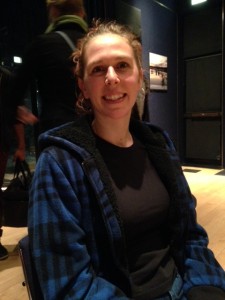
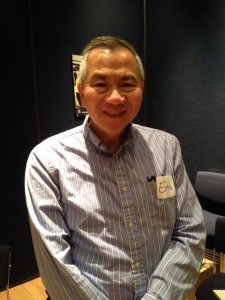
Newcomers Marly Spieser-Schneider and Eddie King share their first impressions on Night School.
On a sunny Monday night, the class was first split up into small discussion groups to tackle a few questions regarding a recent experimental performance created and performed by Jennifer Monson and DD Dorvillier. They watched a short clip from a past performance of RMW (a)/RW and brought up questions regarding intimacy, the impact of lighting, design, and music choices, audience-performer interaction, social commentary, and the strength of the dancers.
UMS director of education and community engagement Jim Leija, who served as substitute teacher in host Clare Croft’s absence, reminded attendees that it was perfectly acceptable to exit the theater and not “get it” – especially in an experimental piece like this one – even if one is a frequent dance performance patron.
Night School attendees were again treated to a panel of an array of experts – this time in the field of music. Melody Racine, U-M Associate Dean for Academic Affairs and Associate Professor of Voice, Joseph Gramley, U-M Assistant Professor of Music and Co-Coordinator of Percussion, and Conductor Yaniv Segal spoke about the movement of the body in orchestral, percussion, and vocal performances in an effort to prepare attendees for the Israel Philharmonic Orchestra on March 15.
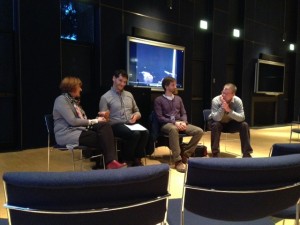
Melody Racine, Jim Leija, Yaniv Segal, and Joseph Gramley discuss body movement in music performance.
Segal began the discussion with a movement exercise intended to convey what exactly a conductor does. The discussion that followed examined the physicality of playing an instrument (and vocal performance), which included the importance of body movement and the necessity of “breath.”
Music performance doesn’t typically get people talking about movement, but attendees were enthusiastic to chat about these genres through the bodies in motion lens. “There was a lot said by the panel that I could identify with as a dancer,” said Marly Spieser – Schneider, a former U-M dance student who was new to Night School. “There’s usually a language barrier between dancers and musicians, and it was nice to hear things that really resonated with me.”
Attendee Geoff Smereck added that Night School has equipped him with a movement vocabulary that transcends performances: “One cross-cutting concept that I’m applying to all performances is harmony,” he said.
For Marly, Night School was a great experience because the discussion didn’t get stuck on one topic for too long. “The first topic could have taken an hour, but it’s good to discuss something and then move on, since some people won’t be able to connect to a particular topic.”
Night School continues at the same time and place on Monday, March 17 at 7 PM in the U-M Alumni Center. The next session – “Dance on Camera” – will focus on creating dance for film. The dance-curious are also invited to check out Gillam dance’s performance of “Sit, Kneel, Stand” at the Berman Center for the Performing Arts on March 12.
Session Resources
- UMS Bodies in Motion Session 6 – Key Theme, Players, and Definitions [Word Document assembled by Marcus White, MFA Candidate – Dance, University of Michigan]
Interested in even more dance engagement? Pick up an adventure card to learn all about the dance activities we’re offering this year and for a chance to win a backstage meet and greet.
Share questions, comments, or suggestions in the comments below.
UMS Night School: Bodies in Motion – Session 5 Recap
Editor’s note: This post is a part of a series of by U-M student Sarah Squillante, who’s covering our free UMS Night School: Bodies in Motion series. Learn along side with them.
Educationally rich. Inspiring. Moving. Authentic. Sharing. These are just a few of the many words UMS Night School attendees provided when asked to summarize their experiences thus far.
“This is making me think so much more deeply about the play,” said Sharman Spieser.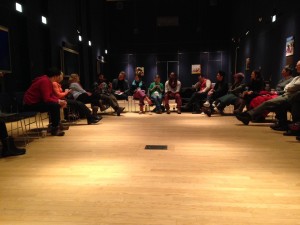
Sharman’s comment was just one among many in a discussion of Théâtre des Bouffes du Nord’s production of The Suit that opened up Monday’s session, led by U-M Professor of Theatre, Jillian Eaton.
Points of reflection concerned the transformation of the play from a short story, the significance of music, the development of the main female character, the subtlety of apartheid undertones, and, of course, movement.
“[Movement] was not a layer that was added on. It was at the core of the performance,” said one attendee.
Host Clare Croft asked attendees how they connected physically with the performance. This was a night school session devoted to Bodies in Motion, after all. Attendees were invited to share how they physically reacted to certain moments, and how they thought they would feel if they were one of the audience members pulled on stage during the audience participation moment in the performance.
“What I’ve learned the most at night school is how movement is a part of everything that you do,” said Lisa Beard.
The session moved to a discussion with this question at its center: What does it mean to experiment in motion? U-M Associate Professor Dance, Amy Chavasse, got bodies moving instead lips, this time using an exercise in which pairs of two walked toward each other, slowly writing their names in the air with a body part. The room buzzed with discussion as soon as the lines collided.
U-M Associate Professor of American Culture, Larry La Fountain-Stokes, emphasized the value in performances that break the dance mold, specifically in regard to the traditional male/female stereotype. One such performance is the upcoming RMW (a)/RW and Toe, performances by DD Dorvillier and Jennifer Monson, performances that came out of a conference called Meanings and Makings of Queer Dance Research. The shows will be performed in the U-M Duderstadt Center Video Studio on North Campus on February. 26 and 27 at 7:30 PM.
The pleasure and value of experimentation was summed up by Clare Croft, who said, “I find that the kinds of performances I like the most are those when I end up saying what’s going on? What’s going on? What’s going on? This is awesome.”
Night School is taking a short break and will resume on Monday, March 10 at 7 PM in the U-M Alumni Center. Our sixth session, entitled “Bodies Make Music,” will delve into the movement of musicians and prepare attendees for the Israel Philharmonic Orchestra.
Interested in even more dance engagement? Pick up an adventure card to learn all about the dance activities we’re offering this year and for a chance to win a backstage meet and greet.
Session Resources
- UMS Bodies in Motion Session 5 – Key Theme, Players, and Definitions [Word Document assembled by Marcus White, MFA Candidate – Dance, University of Michigan]
Share questions, comments, or suggestions in the comments below.
UMS Night School: Bodies in Motion – Session 2 Recap
Editor’s note: This post is a part of a series of by U-M student Sarah Squillante, who’s covering our free UMS Night School: Bodies in Motion series. Learn along side with them.
What is dance? A rhythmic movement? Deliberately choreographed steps? Expression through time and space? What makes someone a good dancer?
This week’s UMS Night School session, held on Monday night, attempted to answer these tough questions and sparked a litany of others. It also welcomed its first guest speaker: U-M associate professor of Movement Science in the School of Kinesiology, Melissa Gross. Gross spoke about her research regarding the relationship between emotion and movement. Her area of study has focuses on mostly pedestrian movements, which have been found to correlate strongly with emotion. “Your emotions impact your body movement and your body movement can impact your emotions, too,” Gross said.
Attendees were invited to conceptualize movement a bit more scientifically, but this invitation quickly inspired questions that carried over to the dance world: How do we account for cultural differences in movement? Are certain people more in tune to others’ emotions (as expressed through movement) than others?
UMS Night School host, Clare Croft (assistant professor of dance at U-M), reminded everyone that this notion can be found everywhere in dance – Martha Graham’s work, for instance, was focused on the idea of translating emotion through motion in a universally accessible way.
Rebecca Rebhuhn (photo left), a U-M Graduate Student in mathematics, was a newcomer: “There aren’t many dance events in Ann Arbor, so I go to all that I can. I used to study dance academically and figured this could be interesting,” she said. Others were back for their second week.
Attendees Susan and Geoff Smereck (photo right) have seen numerous UMS dance performances together. They describe themselves as being “exuberant about dance. “Focusing on movement like we have allows me to not focus so much on the lack of a story line,” said Susan. “[Night School is] prying my brain open and giving me ways of thinking about movement.” Geoff wasn’t surprised by the thought-provoking nature of the evening’s discussions. “This is so U of M,” he said. “I’m looking for the vocabulary to conceptualize the dance performances that I see.”
PhD student Payam Mirghams and U-M graduate Sasha Kapshai share what inspired them to come to Night School.
The session, which was held the day after the Super Bowl, ended with a fitting video of former U-M quarterback Denard Robinson in action. Attendees were asked to describe the movement of football, and then to consider what we could learn from a culture or an idea through this movement.
Night School host Clare Croft demonstrates differences in movement.
Next week’s Night School, “Technique, Virtuosity, and Monsters,” will include a discussion of Moving Pictures, the upcoming U-M Department of Dance performance, and an introduction into hip-hop – just in time for Compagnie Käfig’s Correria Agwa on February 14 and 15. Special guests will include Reighan Gillam, a Postdoctoral research fellow in the U-M department of Afroamerican and African studies, and several U-M Dance Graduate Students. It will once again be held at the U-M Alumni Center at 200 Fletcher Street.
Session 2 Resources for Download
Session 3 prep reading on Capoeira – “Headspin” by Barbara Browning
Session 2 Powepoint Presentation by U-M Assistant Professor of Dance Clare Croft
Interested in even more dance engagement? Pick up an adventure card to learn all about the dance activities we’re offering this year and for a chance to win a backstage meet and greet.
For a complete list of 2013-2014 dance performances, visit ums.org. Share questions, comments, or suggestions in the comments below.
UMS Night School: Bodies in Motion – Session 1 Recap
Editor’s note: This post is a part of a series of by U-M student Sarah Squillante, who’s covering our free UMS Night School: Bodies in Motion series. Learn along side with them.
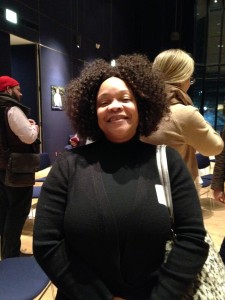
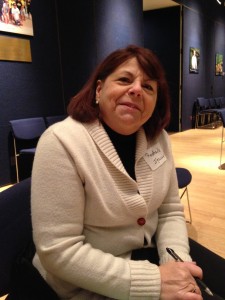
Lisa Beard (Left) and Rochelle Igrison (Right) are both enthusiastic to expand their dance knowledge.
UMS Night School isn’t designed to be a dance class, but the first session got people moving just enough to start to think differently about movement. Community members of all ages and backgrounds stood in a semi-circle in the chilly University of Michigan Alumni Center on Monday night, introducing themselves not just with names but an accompanying gestures.
Clare Croft, assistant professor of dance at the University of Michigan who’ll lead Night School this season, asked what the exercise made everyone think of and what images came to mind when they heard the word “dance.”
One attendee noticed that when the participants were asked to omit their names from the introduction, the gestures were a lot easier to understand and remember, and another suggested that movements can “characterize people and carry meaning.”
Jim Leija, director of education and community engagement with UMS, welcomed participants and said that Night School is an opportunity to “improve our comfort level with dance and make room for a reflective moment.” He emphasized that the program would not be a lecture series, but rather an interactive experience. The first session didn’t disappoint. Participants stretched out their arms in various ways and explored the ways in which even simple movement – like rubbing hands together – can be executed in many ways. Many were eager to suggest topics that they hoped to address in the coming weeks, like why we prefer certain performances over others and how dance evokes political messages.
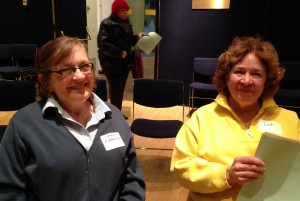
Pat Bantle (Right) is a return night-school student. “I love dance,” she said. “I came last year and I enjoyed it very much.”
Some of the participants seemed excited to engage with a medium that they already love. Lisa Beard drove all the way from Oak Park to participate. “I just turned 50 and I promised myself I’d do things I’d never done before,” she said. A longtime patron of the arts, Beard is excited to meet new people. Rochelle Igrison explained that she’s been to all of the UMS dance performances thus far. “I may not have a dancer’s body, but I can still be a patron of the arts,” she said. “I just love dance.”
Others were more explicit in what they hoped Night School would do for their engagement with the arts. Art, a frequent UMS concert goer, said he was eager to expand his dance vocabulary in order to engage in conversations after performances. “I want to be able to talk about it,” he said.
Croft showed a series of videos that touched on a breadth of dance styles and considerations, from Martha Graham’s Lamentations to a video from the 2008 Beijing Olympics. She suggested, in her parting thoughts, that participants use the sessions not only to “define what dance is, but what it does.”
Next week’s Night School, “Moving Pictures,” will welcome a U-M professor of Movement Science and a professor of Art and Design. It will again be held at the U-M Alumni Center at 200 Fletcher Street. Interested in even more dance engagement? Pick up an adventure card to learn all about the dance activities we’re offering this year and for a chance to win a backstage meet and greet!
Download Sesssion 1 Resources, including key concepts, videos, and vocabulary from the first session [Word Document assembled by Marcus White, MFA Candidate – Dance, University of Michigan]: Bodies in Motion Session 1 Key Themes, Players, and Definitions
For a complete list of 2013-2014 dance performances, visit ums.org. Share questions, comments, or suggestions in the comments below.
UMS Night School: 100 Years of UMS at Hill
Photo: Hill Auditorium’s first audience, May 14, 1913.
This year, UMS Night School focuses on 100 years of UMS at Hill Auditorium and illuminates the special history behind the great performers and performances that have shaped our community. These 90-minute “classes” combine conversation, interactive exercises, and “lectures” with genre experts to draw you into the themes behind each performance. Professor Mark Clague joins us again as host and resident scholar.
Session 8: Going Greek: Milhaud’s Oresteia of Aeschylus and 100 Years of UMS/School of Music Collaborations
Ralph Williams, Professor Emeritus of English at the University of Michigan, gave a lecture on the Oresteia of Aeschylus prior to a UMS Choral Union rehearsal. The UMS Choral Union performs as part of Darius Milhaud’s Oresteia of Aeschylus on April 4.
Also, we interviewed composer William Bolcom, who studied with Darius Milhaud, Kenneth Kiesler, conductor, Jerry Blackstone, chorus master, and Joseph Gramley, co-director of percussion.
Session 6: Sing Out: Soloists at Hill
Richard LeSueur’s picks for Great Soloists: First Half of 20th Century
Enrico Caruso
Jasha Heifetz
Vladimir Horowitz
Sergei Rachmaninoff
Richard LeSueur’s picks for Great Soloists: Second Half of 20th Century
Joan Sutherland
Itzak Perlman
Jessye Norman
Yo-Yo Ma
From the Hill Auditorium Celebration
Complete “Saturday Morning Physics” lecture on Hill Auditorium Acoustics
Session 4: Jazz in the Hall
Night School speaker Mark Stryker’s “Detroit drummer Karriem Riggins makes his mark in jazz, hip-hop” in the Detroit Free Press.
From UMS Lobby, the Detroit Sound Conservancy shares their top 5 picks for must-see Detroit music locations. Karriem Riggins tells us what he’s been listening to lately.
Session 3: HILL-ELUJAH! The Messiah and UMS Traditions at Hill
Resources provided by UMS archivist Richard LeSueur.
A few memorable Hallelujah chorus performances:
Sir Thomas Beecham (re-orchestrated):
Mormon Tabernacle Choir (large chorus):
Trevor Pinnock (small chorus):
Richard LeSueur’s recommended complete recordings of Messiah:
- Trevor Pinnock-Archiv 423 630-2 (superb soloists; wonderful sense of baroque style)
- Charles Mackerras-EMI 69449 (wonderful, small scale performance)
- Colin Davis-Philips 438 356-2 (slightly larger group, excellent soloists)
- Neville Marriner-Decca 444 824-2 (excellent performance)
- Andrew Davis-EMI 17645 (famous soloists)
- Thomas Beecham-RCA 61266 (re-orchestrated; very large chorus and orchestra)
- elmuth Rilling-Hänssler Classics 98434 (Mozart orchestration, sung in German)
And, check out this lovely preview and history of the Messiah on AnnArbor.com
Session 2: Riot! 100 Years of Stravinsky’s The Rite of Spring
Related Material:
Joffrey Ballet’s Reconstruction of the original Nijinksy Rite of Spring
- University of North Carolina – Chapel Hill’s “The Rite of Spring at 100” project website.
- “Stravinksy the Global Dance” web databaseof all known versions of “Rite”
- Film mentioned by Christian Matjias-Mecca, “Stravinsky: Once at a Border”
- Stravinksy Bibliography provided by Jeff Lyman and Beth Genne(of the U-M School of Music, Theatre & Dance).
- Igor Stravinsky: Le Sacre du Printemps Dossier de Presse/Press-Book.Collected by François Lesure. Editions Minkoff, Geneva, 1980: A collection of newspaper clippings, reviews, etc., in several languages, all of which address the first performances of The Rite of Spring in Paris, London, and in many other cities around the world. This is a true “first hand” guide for those of you interested in how the work was received initially.
- A Stravinsky Scrapbook 1940-1971. Robert Craft. Thames and Hudson, 1983 and Igor and Vera Stravinsky: A Photograph Album 1921-1971. Robert Craft. Thames and Hudson, 1982.Both of these books were assembled and annotated by Stravinsky’s assistant Robert Craft. While they may look like “coffee table books” at first, they are full of gems of information on a number of fronts, and I’ve looked to these for the many hidden facts and leads that I alluded to the other evening. You can read about the kind of life that Stravinsky led as a celebrity as well as a composer, and you can find plenty of timely information about his compositions after the “Big 3 Ballets,” his conducting engagements around the world, his recordings, and about his very busy life simply being Stravinsky.
- Stravinsky: The Composer and His Works. Eric Walter White.University of California Press, 1984. This is the most complete general reference work on all of Stravinsky’s compositions. In it you’ll find information on the date and circumstances of each work, the instrumentation, a brief description, some performance and recording history, etc. It may lead you to more works by the composer that you’ve not yet had a chance to encounter.
- Proof Through the Night: Music and the Great War. Glenn Watkins. University of California Press, 2003.
Many of you know our Professor Emeritus of Music Glenn Watkins, who you may recall was a good personal friend of Stravinsky. (Stravinsky in fact wrote the foreword to Watkins’ first book on the composer Gesualdo.) This book includes interesting chapters on Stravinsky’s work during the period of World War I, and how the circumstances of the war affected his music in style, in orchestration, in subject matter and more. In addition, the chapter on Ravel and especially the discussion of Ravel’s Concerto for the Left Hand will have you rushing to your cd players to hear the work again. - For all of the composer’s recordings of his own music, search the terms “Stravinsky conducts Stravinsky” and “Sony Classical.”Sony Classical took over Columbia Records, and Columbia was the company with which Stravinsky was contracted to make many of his recordings. They are all available on CD and via digital downloads.
- Stravinsky’s assistant Robert Craft began a series of recordings in the early 1990s with the plan to re-record all of Stravinsky’s works, from the most famous to the most obscure, and in every version of those that had been revised by the composer. I’m not sure he has finished it yet, and it has gone through a series of companies, some of which are no longer in business. Many of them are available on the Naxos label, others on MusicMasters, still others on Koch.
Other materials of interest:
- Stephanie Jordan, Moving Music, London: Dance Books (chap on Balanchine)
- Stephanie Jordan, Stravinsky Dances, London: Dance Books, 2011)
- Charles Joseph: Stravinsky and Balanchine, New Haven: Yale University Press (2002; paperback 2011)
- Charles Joseph: Stravinsky’s Ballets, New Haven: Yale University Press, 2011 or 12
- The Dance Element in Strawinsky’s Music.’ In ‘Strawinsky in the Theatre: A Symposium,’ edited by Minna
- Lederman. Dance Index 6:10, 11, 12 (October-December 1947), 250-56. Reprinted in Stravinsky in the
- Theatre, edited by Minna Lederman. New York: Pellegrini & Cudahy, 1949, pp. 75-84.
- George Balanchine: “The Dance Element in Music in Lederman, Minnie
Session 1: Iconic Hill: Culture, Community, and the Concert Hall
Related Material:
- Professor Mark Clague’s Article from The Opera Quarterly: The Industrial Evolution of the Arts: Chicago’s Auditorium Building (1889–) as Cultural Machine
- Info Sheet on the early history of Hill Auditorium and UMS (created by Charles Reischl)
- AADL’s UMS Archive
People are Talking: UMS Night School – Session 4
UMS Night School is a free and open to the public series of “classes”, which include a 30-minute discussion of each performance in Pure Michigan Renegade, plus a 60-minute intro session for the next performance on the series. You’ll find follow-up conversation, coverage, and materials here on the Lobby.
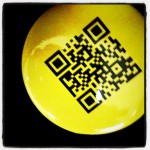 See someone with this button? Start a conversation about ‘renegade’ works.
See someone with this button? Start a conversation about ‘renegade’ works.
SYLLABUS
HOMEWORK
“Required Reading” and “Required Watching” from Malcolm Tulip, Associate Professor of Theatre at U-M
1. The Turnip Princess: a newly-discovered fairy tale
“Once upon a time, the historian Franz Xaver von Schönwerth collected fairytales in Bavaria, which were locked away in an archive until now.”
2. Interview with Robert Lepage for Theatre Music Canada.
In Lypsinch (2007) Lepage intends to “show us a mosaic of human struggles for identity, to assemble a composite portrait of contemporary society voicing over and dubbing out our primal emotional needs. Lepage wants to make us aware of how we control and doctor the sounds surrounding us to cover up the voices of those in genuine need.” via Village Voice
3. Director Robert Lepage Speaks on what inspired him to create The Nightingale & Other Short Fables, a collection of works by composer Igor Stravinsky that made its world premier in October 2009.
4. More about The Andersen Project
A slideshow of images from the production
Preview in Paris Voice: “the piece is not a retelling of any one of Anderson’s tales but rather an open-ended study, undertaken to examine, create around and perhaps finally understand better both the creator and his work.”
5. More about Hans Christian Andersen
The Hans Christian Andersen Center (with complete works)
The Dryad
The Shadow
Elsewhere on the Lobby:
Our interview with The Andersen Project’s lead actor Yves Jacques, and 5 Things to Know About The Andersen Project.
YOU SUGGESTED…
We’ll add your suggestions for further reading, listening, and watching here.
What did you think of this session of Night School? What’s still not making sense? What are you excited about?
UMS Night School Report – Einstein on the Beach
On the topic of “maverick,” one of the words being used to describe the artists on offer in the Renegade series, I learned at yesterday’s first UMS “Night School” session that its primary meaning is an “unbranded calf or yearling.” The term comes from one Samuel Augustus Maverick (1803-1870), an American rancher who refused to brand his own calves so that he could claim any unbranded calf he found as his own. Needless to say, he wasn’t a popular guy in his neighborhood. More broadly, the word “maverick” refers to something—a calf, for instance, or maybe a composer—that lacks any markings of ownership. I suppose that’s what John McCain had in mind in four years ago, but I’m glad UMS is reclaiming the word for us in something like its original context, and I’m intrigued to think of artists like Robert Wilson and Olivier Messiaen (whose From the Canyons to the Stars is next up in the Renegade series) as stubborn ranchers who flat-out won’t, or can’t, brand their work.
Lots of talk at last night’s class—attended by more than 70 people—about what to expect at next week’s Einstein on the Beach. Instructor Mark Clague went over what EoB is (an opera with poetic texts, recitative, an orchestra pit, and a mythic hero) and is not (Aida). Of particular note are the work’s five-hour length and non-narrative structure, and the attendant challenges for audience members. If I leave to go to the bathroom, how will I know what I’ve missed? people wanted to know. Just how repetitive is it? I caught up with Dennis Carter, head usher for UMS, who came to last night’s class to prepare himself for next week’s event.
Inspired? What do you think it means to be a “renegade”?


